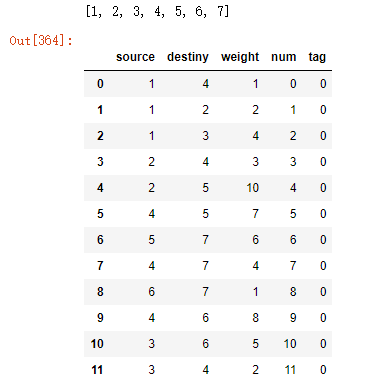学习的时候,觉得这篇资料蛮好的:
https://www.cnblogs.com/JayShao/p/12381830.html
然后这篇文章比较新颖,自觉比较适合写代码的理解:
https://www.geeksforgeeks.org/kruskals-minimum-spanning-tree-algorithm-greedy-algo-2/
代码也比较齐全,我自己动手试试吧!
Prim:生成过程中,Edge 必然连着

source = [4,1,1,2,2,5,5,7,7,6,6,4]
destiny = [1,2,3,4,5,4,7,4,6,4,3,3]
weight = [1,2,4,3,10,7,6,4,1,8,5,2]
# -- 这个是错误解答: PRIM 用 AOV 试试
tmp_graph = pd.DataFrame()
tmp_graph['source'] = source
tmp_graph['destiny'] = destiny
tmp_graph['weight'] = weight
tmp_graph['num'] = tmp_graph.index
tmp_graph['tag'] = 0
基础准备函数
# ----------
# -- Prim
# ----------
# -- SWAP
def swap_val(a, b):
tmp = a; a = b; b = tmp;
return a,b
# -- 改成无向图
def graph_order(g_in):
for i in range(len(g_in)):
if (g_in['source'][i]>g_in['destiny'][i] ):
g_in['source'][i], g_in['destiny'][i] = swap_val(g_in['source'][i], g_in['destiny'][i]) # 一定要用return
return g_in
# -- Minimum - return num
def find_min_weight(g_in):
# -- renew
tmp_g = g_in.reset_index(drop=True)
tmp_min = tmp_g['weight'][0]
tmp_min_ind = tmp_g['num'][0]
for i in range(1,len(tmp_g)):
if (tmp_g['weight'][i] < tmp_min):
tmp_min = tmp_g['weight'][i]
tmp_min_ind = tmp_g['num'][i]
return tmp_min, tmp_min_ind
# -- 初始排序
tmp_graph = graph_order(tmp_graph)
# ------ 获取节点向量
tmp_vertex = list(tmp_graph['source']) + list(tmp_graph['destiny'])
tmp_vertex = list(set(tmp_vertex))
print(tmp_vertex)
tmp_graph

微封装的循环搜索 Prim 算法
复杂 O(n2)
vertex_selected=[1]
edge_weight=[]
tmp_v_ind = 1
# -- End Case
# 1.vertes_selected 维度与原维度一致,显示被选入顺序
# 2.edge_weight 向量维度与原图维度一致,显示 Aggregated Weight
# 3.上述两个向量长度不一致
cnt_tot = len(tmp_graph)
j=0
is_break=0
count=0
while ( len(vertex_selected)<cnt_tot and is_break==0):
tmp_2=pd.DataFrame()
for i in range(len(vertex_selected)):
# -- 处理 Ind 产生一个内部循环
ind_select_1 = (tmp_graph['source']==vertex_selected[i])
ind_select_2 = (tmp_graph['destiny']==vertex_selected[i])
ind_select_3 = (tmp_graph['tag']==0)
ind_select=[]
for k in range(len(ind_select_1)):
ind_select.append( (ind_select_1[k] or ind_select_2[k]) and ind_select_3[k] )
# print(ind_select)
tmp_3 = tmp_graph[ind_select]
if (i==0):
tmp_2 = tmp_3
else:
tmp_2 = pd.concat([tmp_2, tmp_3])
if (len(tmp_2)>0):
# -- 找到最小值的 ind
min_weight, min_weight_ind = find_min_weight(tmp_2)
# -- 两端 tag == 1
tmp_graph['tag'][tmp_graph.num == min_weight_ind]=1
# -- 是否有环路
is_source_existed=0
tmp_dest = tmp_graph['destiny'][min_weight_ind]
for k2 in range(len(vertex_selected)):
if (vertex_selected[k2]==tmp_dest):
is_source_existed = 1
break
is_destiny_existed=0
tmp_dest_1 = tmp_graph['source'][min_weight_ind]
for k3 in range(len(vertex_selected)):
if (vertex_selected[k3]==tmp_dest_1):
is_destiny_existed=1
break
# -- append
if ( is_source_existed==0 or is_destiny_existed==0):
if (is_source_existed==0):
vertex_selected.append(tmp_dest)
else:
if(is_destiny_existed==0):
vertex_selected.append(tmp_dest_1)
edge_weight.append(min_weight) # Prim 生成一颗树
#print("min_weight: ", min_weight, min_weight_ind)
#print("vertex_selected: ", vertex_selected)
#print("edge_weight: ", edge_weight)
j=j+1
count=count+1
else:
is_break=1
print("Edge Weight: ", edge_weight, "\n")
print("Vertex Selected in Order: ", vertex_selected, "\n")
print("Number of Vertex in SET:", len(vertex_selected), "\n")

结论:
第一个向量是选入边的权重,该向量的权重之和就是 Spinning Tree 权重之和,向量维度就是边的数量;
第二个向量,是选入点的顺序(ID)。

Kruscal:最小生成树,AOE_sigma 必然最小,生成过程中,Edge 可不连续
并查集:https://www.bilibili.com/video/BV1b7411N798?p=55
王道数据结构,用森林的概念,识别出不同子集。
注意数据结构。

